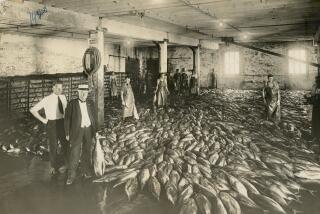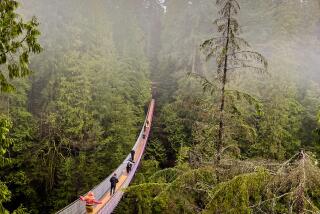Outer Island Idylls
HONG KONG — It’s been uncommonly cold here. Whitecaps frost the channel between Kowloon and Hong Kong Island, where an ominous cloud has shrouded Victoria Peak for days. The whole city has an unhealthy pallor: gray skyscrapers, gray streets, gray dawn. Even the trusty and venerable Star Ferry, at 6:30 making the first of its 420 daily crossings between mainland Tsim Sha Tsui and old Victoria (now called Central) on the island, looks like a gray ghost in the mist.
I’m on a different ferry, riding hard over pewter waves as a stinging salt spray rinses the bow, and somber Chinese women clasp handbags to their bosoms. The Hong Kong skyline looks like a badly exposed black-and-white negative fading over the stern.
January is not the best time to be fooling around this channel, and I think about how much this city has changed since I was last here four years back and in many visits before that. Since the British ceded control two years ago, Chinese bureaucrats, in their fixation with numerical metaphors, have insisted that China and Hong Kong will remain “one country, two systems” for another 50 years--decades in regular calendars, a mere nanosecond in the Chinese way of thought.
But Hong Kong is still Hong Kong, the most astonishingly beautiful and exotic of Her Majesty’s former possessions, with its skyscrapers squeezing against mountains, its anthill of humanity riding double-decker buses and boarding high-speed hydrofoils that churn the channel--a sea of people packed in a staggering city-state, crowded and improbable. I’m staying with friends in Central--and I’m on this ferry, getting away from it all, heading for what Hong Kongers call “the outlying islands.” A group of schoolgirls on what’s no doubt a class outing shriek happily on the stern as the ferry splashes water on them and Lamma Island--about five square miles and the third largest of the outlying islands--emerges from the gray.
The ferry docks at Yung Shue Wan (Cantonese for Banyan Tree Bay), a fishing town on a horseshoe-shaped bay where most of Lamma’s 8,000 residents live. There are no cars anywhere. In fact, Lantau is pretty much the only outlying island with drivable roads. There are good bargains in Lamma’s craft shops near the pier, but buying things here would mean having to carry them all day.
Day-trippers might prefer to rent bicycles in the quaint village, whose most prominent landmark is the 100-year-old Tin Hau Temple, dedicated to the Taoist goddess of the sea. This is a typical house of worship in the boondocks, dark and thick with incense smoke. Tin Hau, veiled and beaded, glares from behind a spirit stand (something like an altar rail), warding off evil spirits.
Lamma is crisscrossed by hiking paths winding through rolling hills and along spectacular seascapes. The walk to Sok Kwu Wan (Picnic Bay), Lamma’s second largest village, is over a concrete path bisecting the island through hills and valleys, passing the mouth of some nifty caves, once the redoubt of pirates.
In this village, one of the hidden culinary treasures of Hong Kong, one finds a row of waterfront restaurants--modest, efficient and clean. Lacking in frills, they make up for it with the delectable meals that pop from their kitchens. It’s difficult to pick the best one, but a friend who should know recommended Rainbow Seafood, and she wasn’t exaggerating when she told me that a meal there was well worth the trip to Lamma.
I ordered sweet and sour fish, vegetables with scallops, fried rice, chicken with prawns, and sweet rice cakes and tea for dessert. The tab? About $8.
I lingered in Sok Kwu Kwan the rest of the afternoon, bantering with fishermen and cooks before reluctantly continuing down the path to Mo Tat Wan, a tiny village on the lee side full of expatriates and with the best beach on Lamma, to wait for a ferry to Aberdeen and a cab back to Central and the bustle of Hong Kong.
It’s morning again and I’m on another ferry ($2.20), this time heading for Cheung Chau (Long Island), a one-square-mile dot just off the southeast tip of Lantau Island that the British called Dumbbell because of its shape. There are no cars and only one serious settlement, although it’s the most populous of the outlying islands. I hopped off the ferry to be greeted by a McDonald’s at the end of the pier.
Hamburger joints notwithstanding, the town is entirely Chinese in character and fully dependent on its fishing nets.
Every May for three days Cheung Chau holds its Ta Chiu festival, which honors the Taoist god Pak Tai, ruler of darkness and protector of fisherfolk. There are dragon lines, Chinese operas, lion dancers and bands. So-called “floating children,” elaborately costumed, appear to dance over the crowd; actually, they’re held high atop bamboo poles, cleverly strapped into metal supports hidden under their clothes.
I tried my luck at casting fortune sticks in the Pak Tai Temple, where a priest told me that the gods suggested I stay home and mind my own business. Pondering the wisdom of that, I walked around the square in front of the temple, hearing the yelps from high-stakes gamblers in the mah-jongg parlor next door. There were great buys in the jade shops lining the alleys.
Back at the pier, I stopped to study the huge, garish signs on which the village announces recent marriages, and to haggle with the skipper of a kaido (water taxi) over the price of a five-minute ride to Sai Wan village, south along the island’s west coast.
We settled on two Hong Kong dollars (about 25 cents), but he made me cast the mooring lines before we puttered across the harbor, passing fishing sampans and getting a close look at people living on board.
There are some nice temples in Sai Wan dedicated to Tin Hau. From there, it’s an easy walk to the absurdly nicknamed Italian Beach (Pak Tso Wan Beach) to peek into the cave where the bloodthirsty Chinese pirate Cheung Po Sai once hid from the British navy. The cave is near Tung Wan Beach, a pretty cove that’s usually packed in summer.
There are great seafood restaurants in Cheung Chau near the ferry pier, as befits a fishing village, and I walked back there for lunch and whiled away the afternoon watching fishermen.
The ferry from Hong Kong to Lantau (“broken head” in Cantonese) Island is very modern. It’s used by commuters who work in Hong Kong but live in Lantau, the largest isle in the archipelago--twice the size of Hong Kong itself--a wooded and beautiful place.
As the ferry casts off from Hong Kong’s Outlying District Pier, I sip coffee to ward off the morning chill. The city skyline drifts by the steamy portholes as groups of Chinese read the latest news about the Clinton scandal.
We docked at Mui Wo (Plum Blossom), which the British called Silvermine Bay. It’s actually possible to drive from Hong Kong to Lantau because Chek Lap Kok, Hong Kong’s spiffy new airport, which opened in July, is built on reclaimed land on the northwestern shore. However, cars without Lantau tags aren’t allowed access to the south half of the island, where most everything worth seeing is.
In Mui Wo, I walked two blocks to the bus station to catch a ride to Tai O, a fishing village that exemplifies what life was like a century ago in these parts. The bus ($1.30) rolls past pristine Chuen Sha (Long Sand) Beach and a sparkling, panoramic bay (you won’t want to take accommodations in the drab buildings; it’s a maximum security prison), up a hill and down on the west side into Tai O, the best and largest village on the island. It has touches of ancient Bangkok, with fishing boats, canals and houses built on stilts. The whole place reeks of drying salted fish, the town’s main industry.
I spent the morning in Tai O and caught another bus to the Po Lin (Precious Lotus) Monastery, a Buddhist retreat high in Lantau’s western hills that draws tourists by the busload to gawk at the world’s tallest outdoor bronze Buddha.
The Buddha was made in Beijing by, believe it or not, the China Astronomical Industry Scientific and Consultative Corporation, makers of rockets and satellites. It reigns over Lantau with a beatific smile, facing, of course, mainland China.
Po Lin has the flavor of a spiritual amusement park, with its immaculate grounds, a rather gaudy temple and a highly profitable vegetarian restaurant. The food is delicious. Buy a meal ticket ($10.50) at the entrance, wait for a gong to announce that a meal is being served, find a table and wait for the delights. The Buddhist nun-chefs prepare a variety of imaginative dishes. Mashed taro root is coated with vegetarian batter, then deep fried and seasoned to taste exactly like fried fish. Some obscure vegetables in the rice will make you swear that there are tidbits of pork and egg in it.
If there’s only time to visit one outlying island during a visit to Hong Kong, Lantau should be it.
Very early one morning, while Hong Kong stretched its arms and yawned, when it was too early even to go watch the old women doing tai chi ch’uan exercises in Kowloon Park, I made my way to the immaculate subway to head for the New Territories. At Ma Liu Shui, near the Tai Po village subway stop, a ferry leaves for Tap Mun Chau (Pagoda Gates), known to the British as Grass Island.
The trip takes about three hours, with five stops along Tolo Bay, the pearl fishing capital of China during the 8th century Yuan Dynasty. Tap Mun Chau is the most remote island in the archipelago, and its harbor is packed with seiners and work boats. It’s well worth a trip, if only to hike trails with spectacular views that on a clear day stretch all the way to China.
A 100-year-old temple to Tin Hau usually is crowded with fishermen making offerings and praying, since it’s the last chance to worship before reaching the open sea. When the wind blows from the east, it makes a howling and ominous hum in a crevice under the altar. Fishermen swear that the wail portends storms.
I left Tap Mun Chau late that afternoon and was in Hong Kong in less than three hours, feeling as if I had moved through a time warp, from those beautiful and pastoral islands into the vortex of an ultramodern city.
(BEGIN TEXT OF INFOBOX / INFOGRAPHIC)
GUIDEBOOK
Hong Kong Highlights
Getting there: Two airlines, Cathay Pacific and United, fly nonstop L.A.-Hong Kong. Round-trip fares begin at about $1,170.
Where to stay: Mandarin Oriental, 5 Connaught Road, Central; tel. 011-852-2522-0111, fax 011-852-2810-6190. High-end hotel near the waterfront. From about $250 per night for two.
Miramar, 130 Nathan Road, Tsim Sha Tsui; tel. 011-852-2368-1111, fax 011-852-2369-1788. Restaurants, bar, coffee shop, gym and swimming pool. From about $120 per night.
For more information: Hong Kong Tourist Assn., 10940 Wilshire Blvd., Suite 1220, Los Angeles, CA 90024; tel. (800) 282-4582, fax (310) 208-1869, Internet https://www.hkta.org.
More to Read
Sign up for The Wild
We’ll help you find the best places to hike, bike and run, as well as the perfect silent spots for meditation and yoga.
You may occasionally receive promotional content from the Los Angeles Times.






